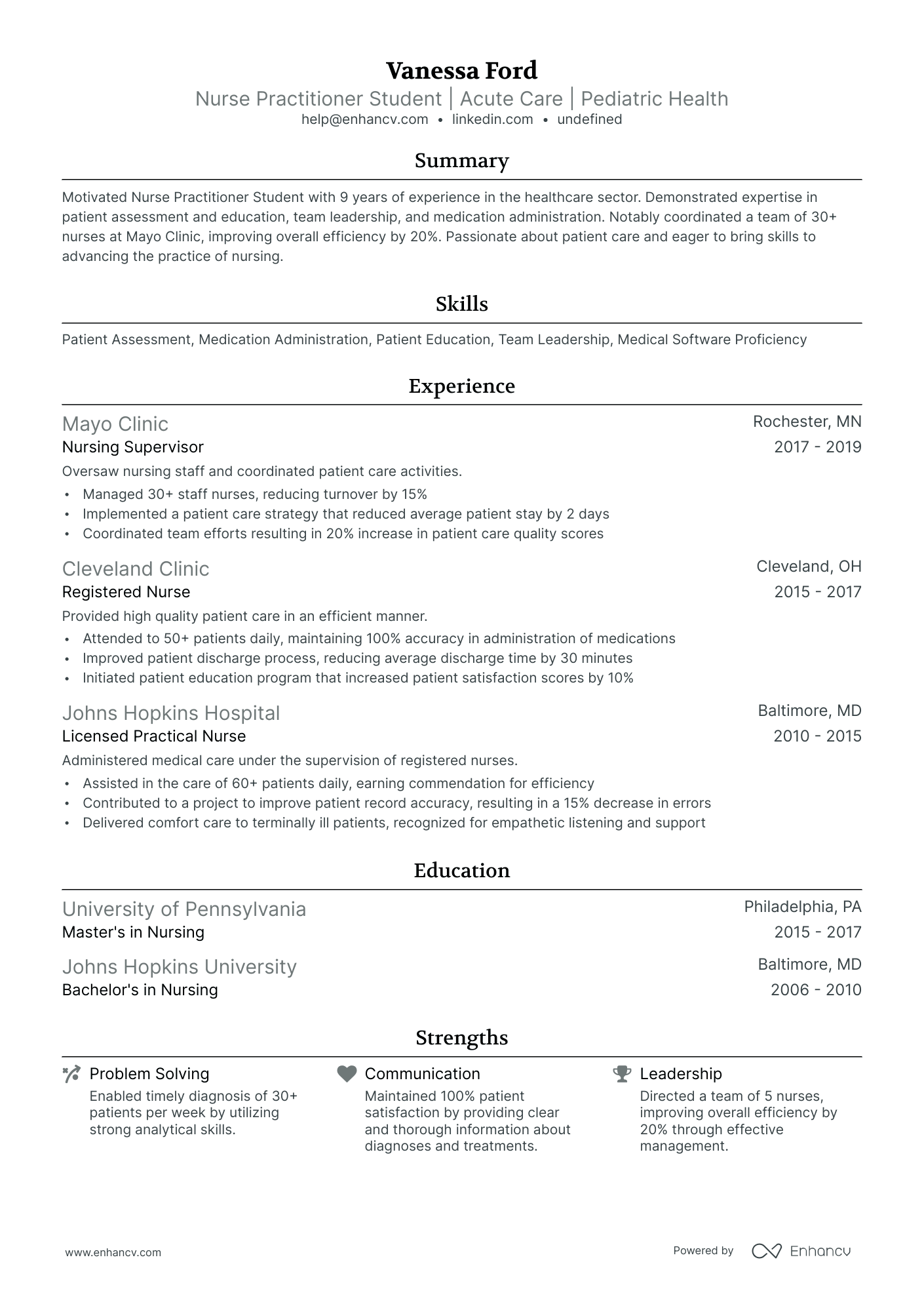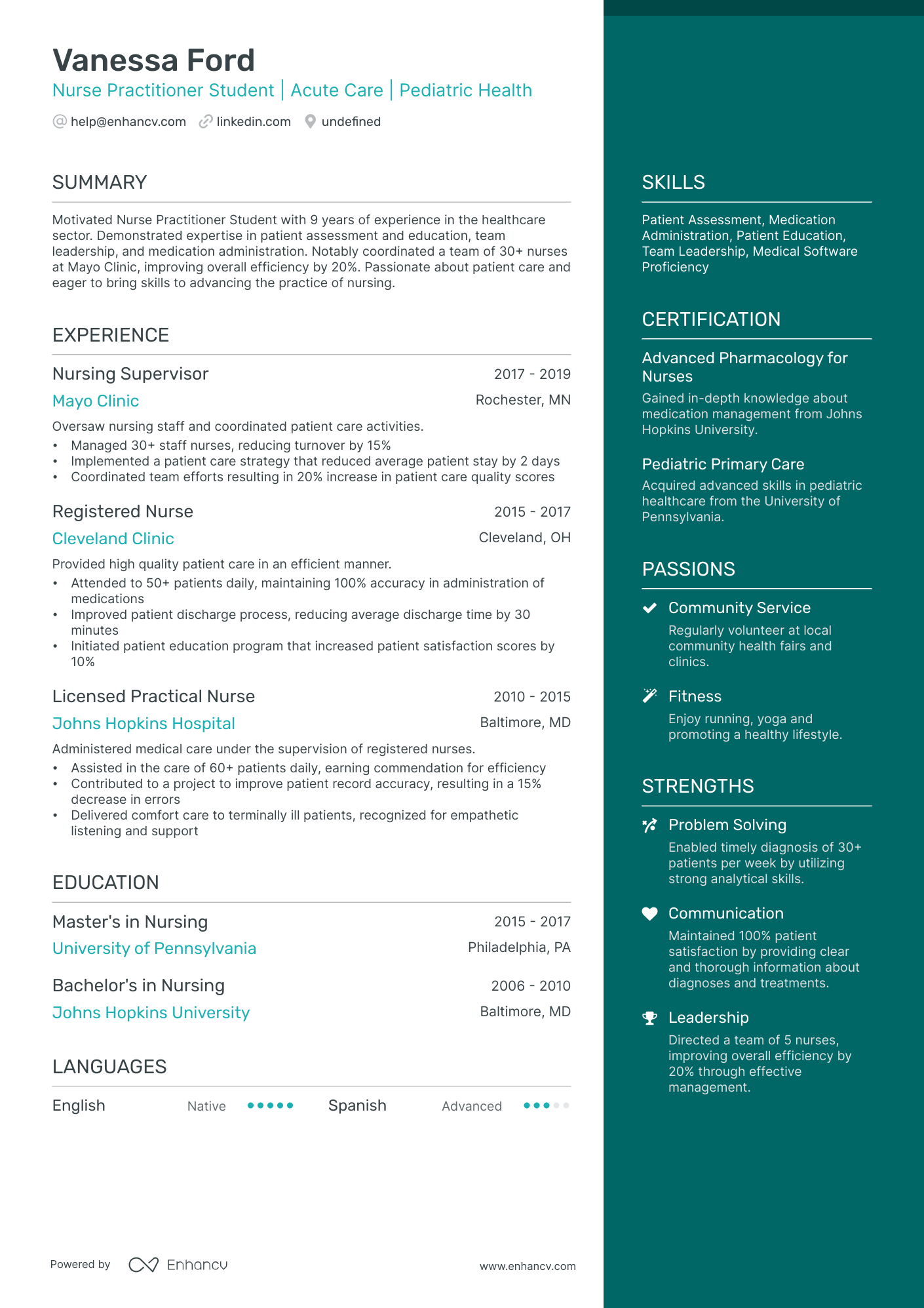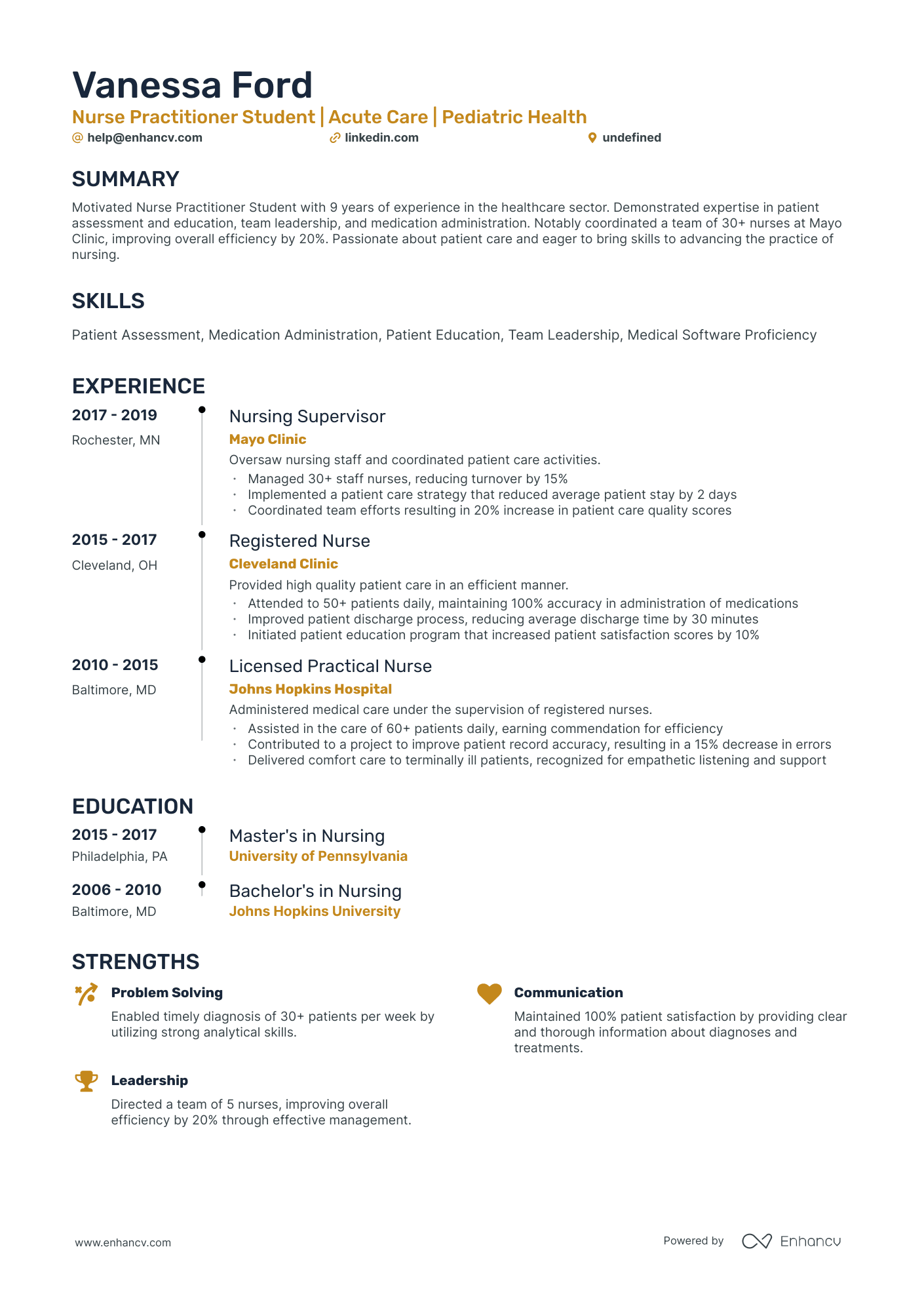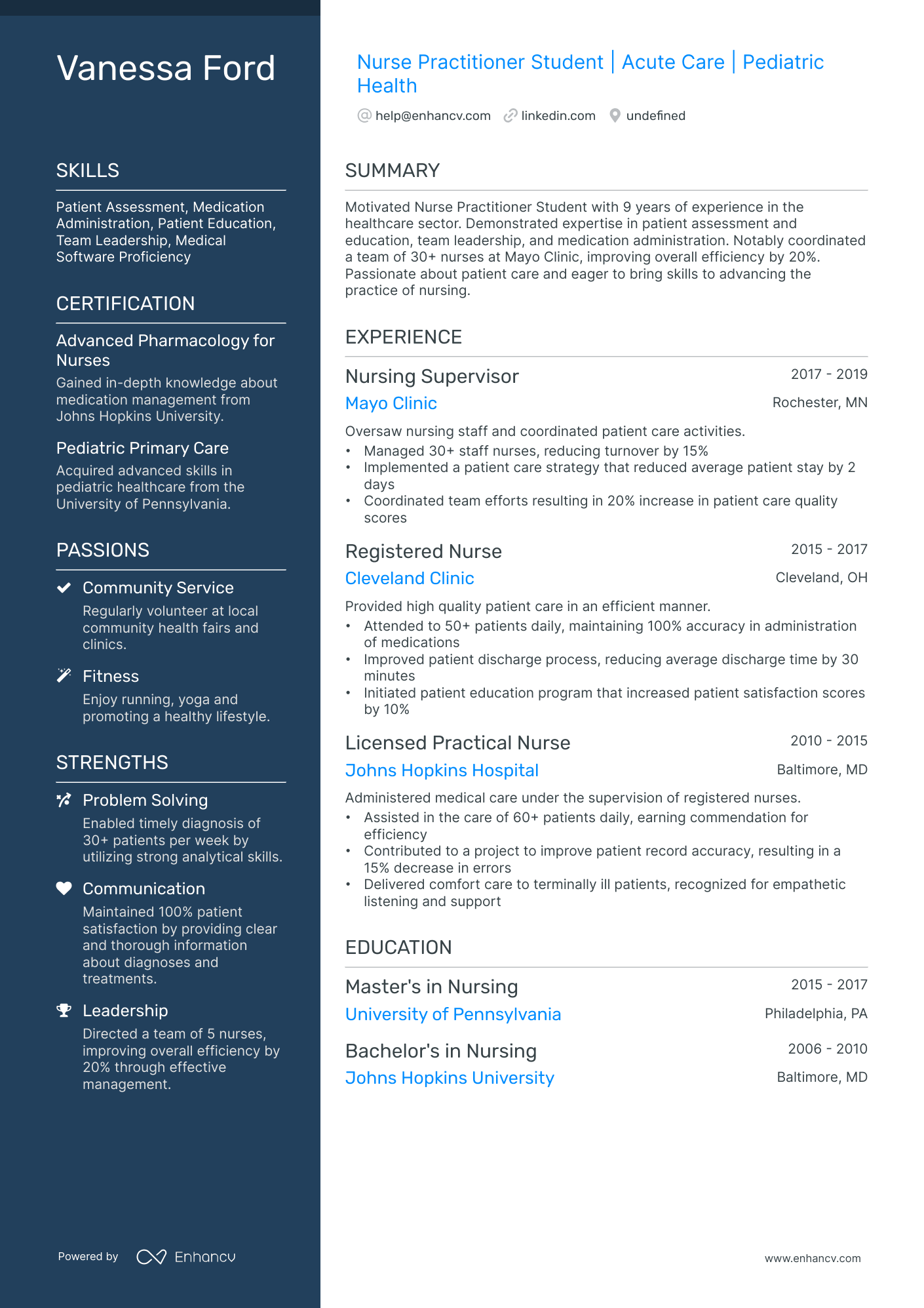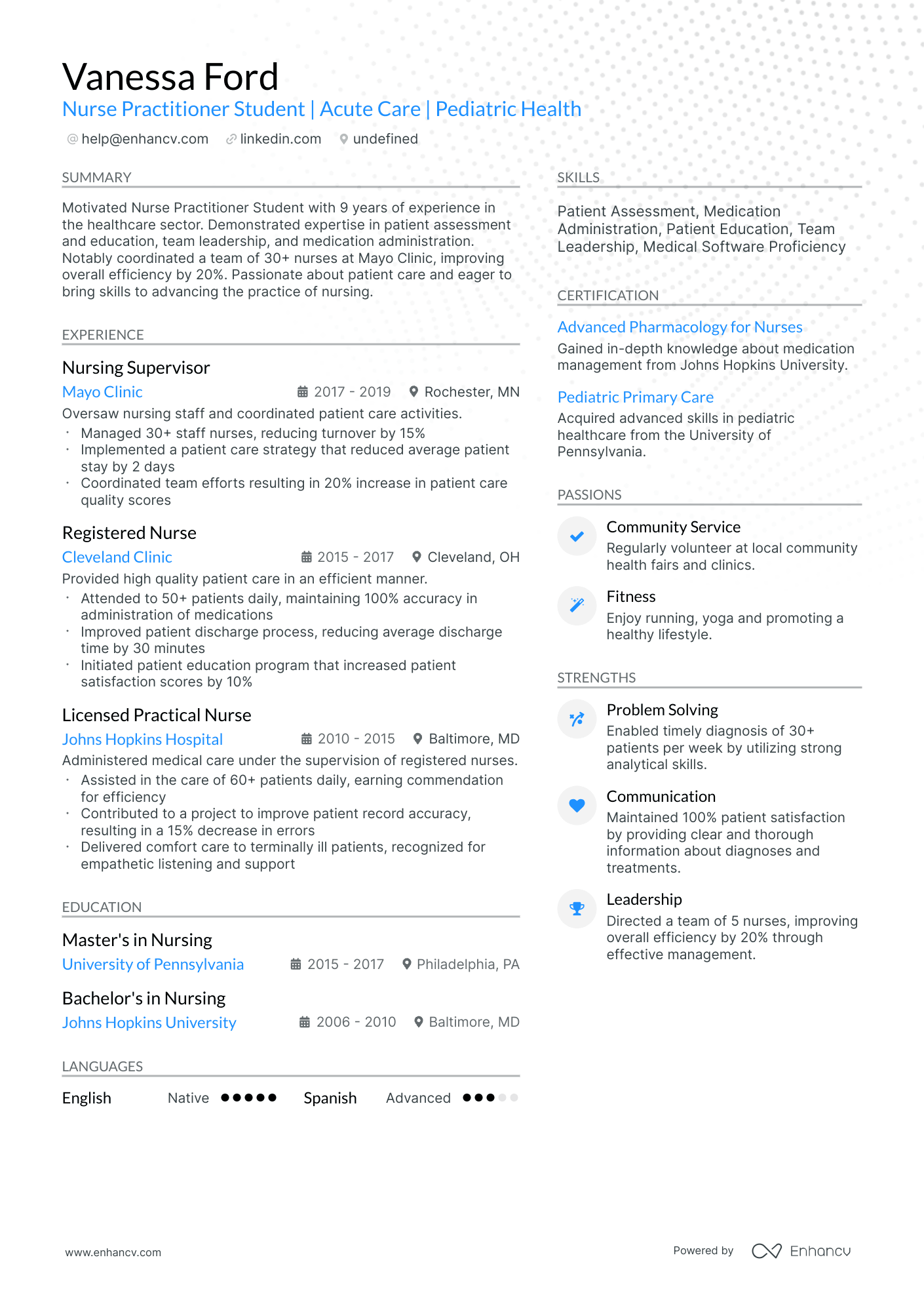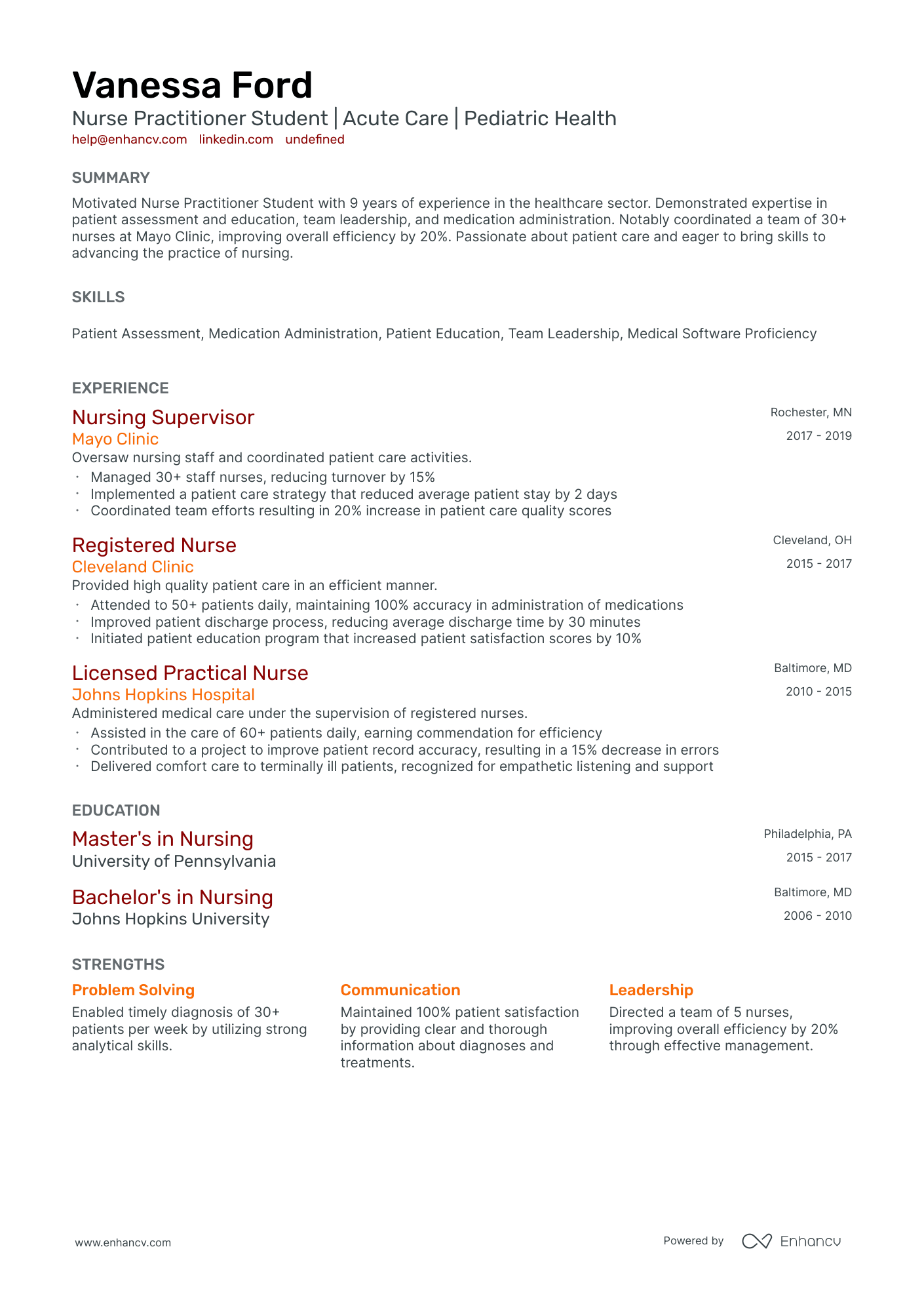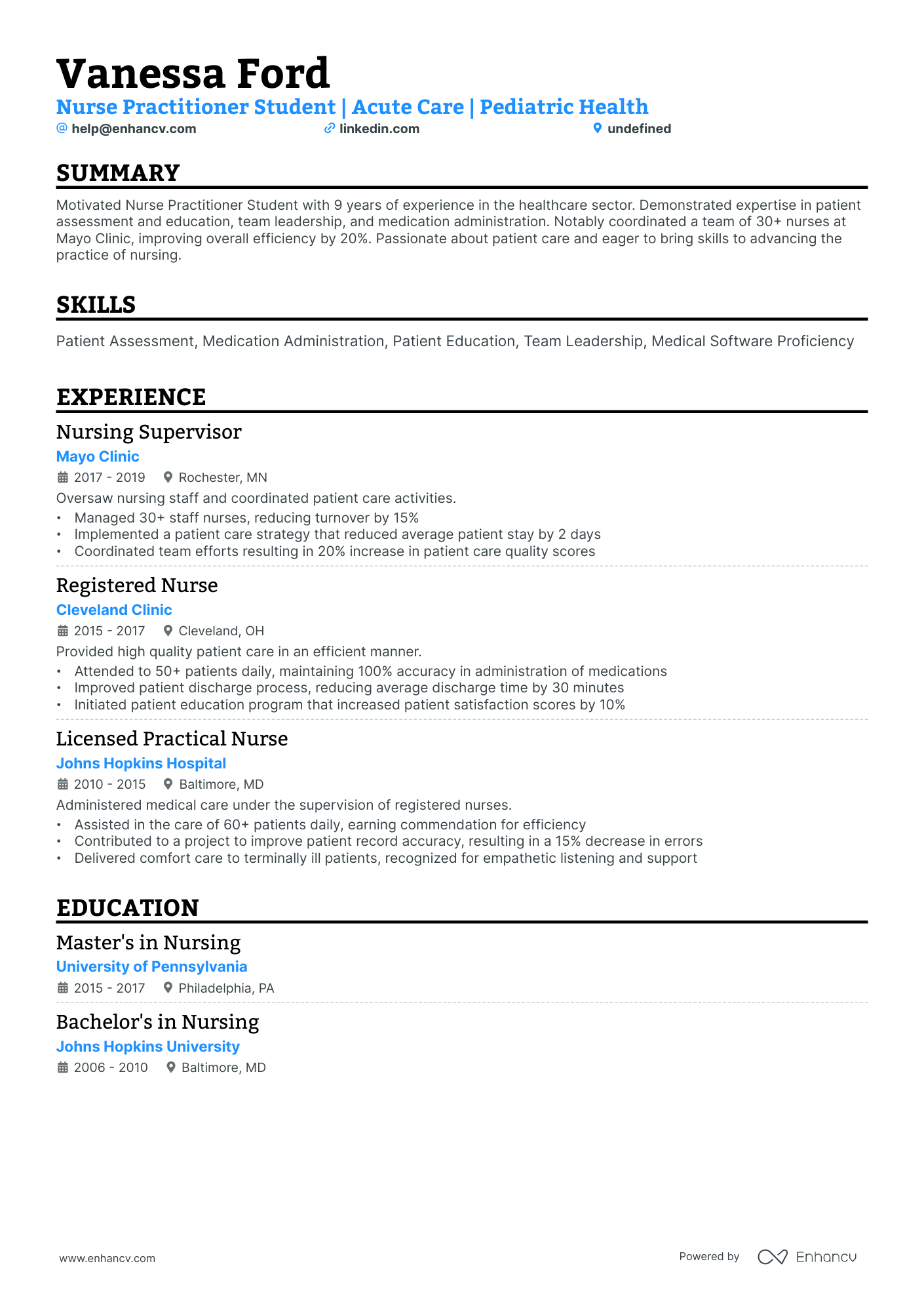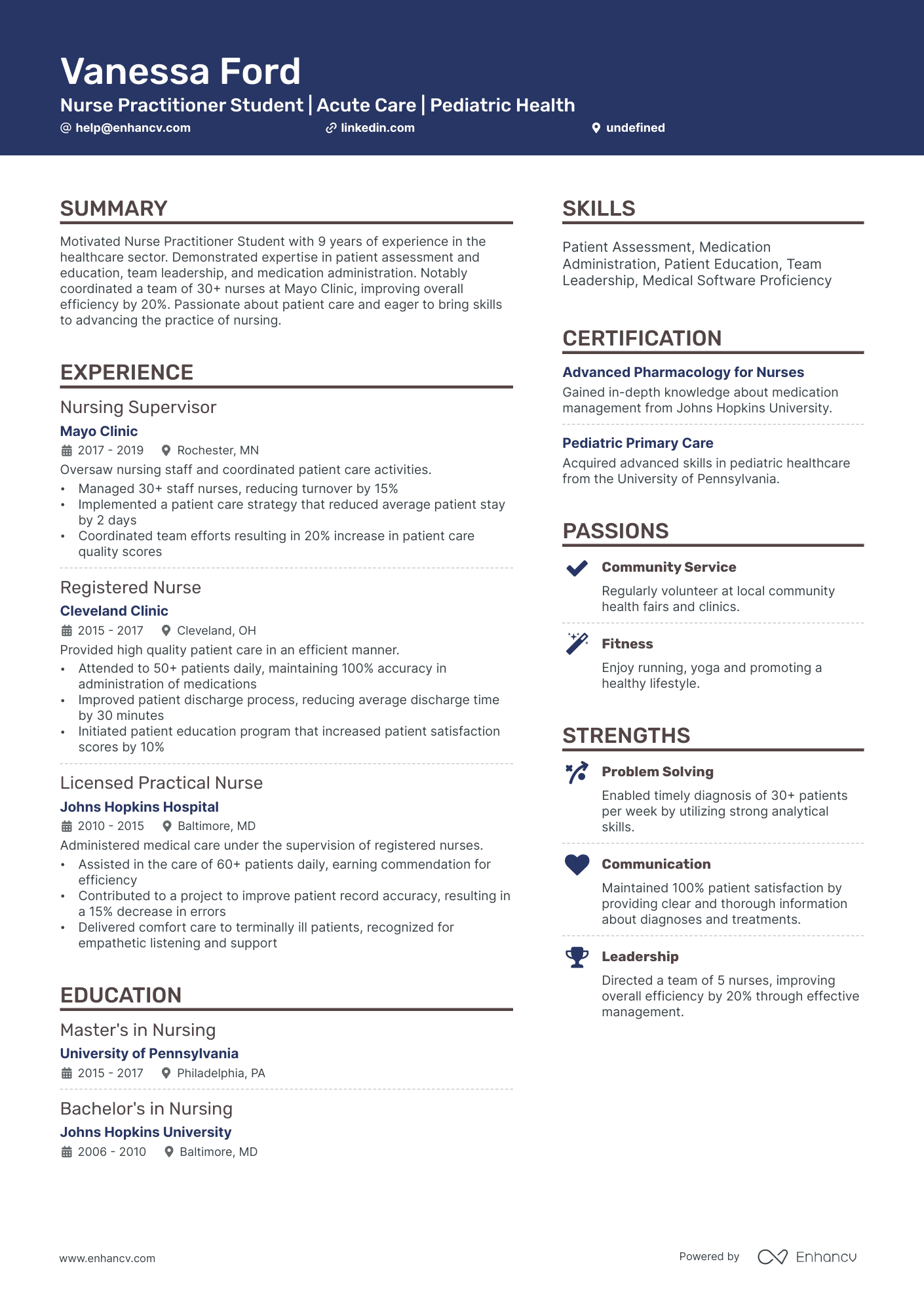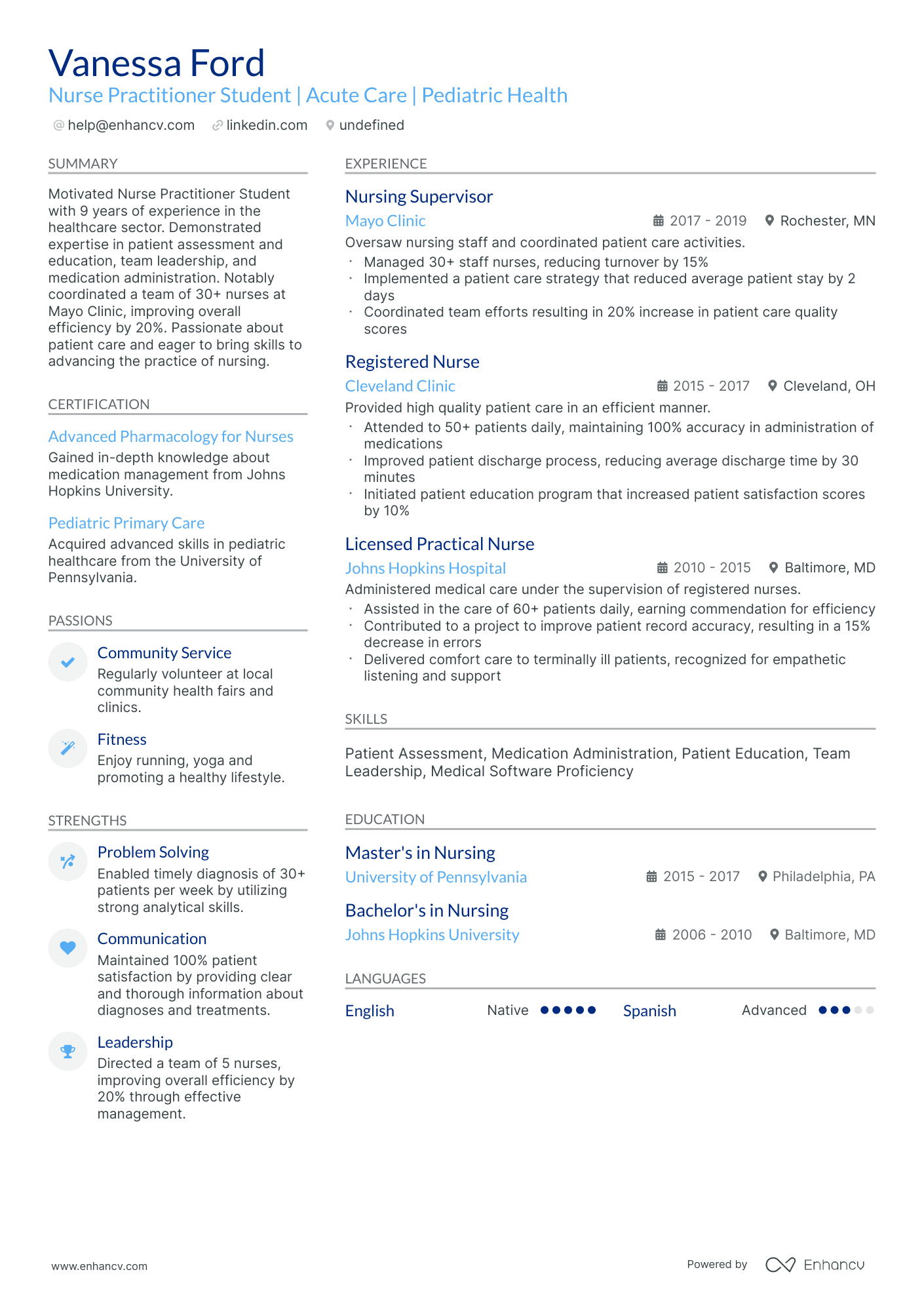A common resume challenge faced by nurse practitioner students is demonstrating their clinical skills and experiences effectively given their limited work history. Our guide offers precise strategies on how to leverage your academic projects, internships, and rotations to showcase relevant skills and hands-on experiences, making your resume appealing to potential employers.
Dive into this guide to learn how to craft a nurse practitioner student resume that offers recruiters a clear view of your career journey:
- Draw from our nurse practitioner student resume samples, highlighting top skills, certifications, and more.
- Illuminate the potential impact you can bring to an organization through your resume summary and experience.
- Spotlight your unique nurse practitioner student expertise, emphasizing tangible results and standout achievements.
Recommended reads:
Structuring your nurse practitioner student resume to engage recruiters
The presentation of your nurse practitioner student resume is crucial.
Is it easy to read and well-organized? Does it have a logical flow?
Avoid overwhelming recruiters with a cluttered document. Instead, follow these best practices to ensure a consistent resume format:
- Include a header in the top third of your nurse practitioner student resume for easy contact and quick access to your professional portfolio or LinkedIn profile.
- In the experience section, start with your most recent role and detail your career in a reverse-chronological order.
- Unless specified, submit your resume as a PDF to maintain its layout. Some companies might request other formats.
- If you're applying for a senior position and have over a decade of relevant experience, a two-page nurse practitioner student resume is acceptable. Otherwise, aim for a single page.
Upload your resume
Drop your resume here or choose a file. PDF & DOCX only. Max 2MB file size.
Pro tip
Choose a functional resume template that offers ample space to showcase your unique nurse practitioner student expertise.
Essential sections for a standout nurse practitioner student resume:
- The top section should combine your header—with accurate contact details—and a concise summary or objective that encapsulates your professional achievements.
- An experience section that chronicles your career trajectory and how each role contributed to your professional development.
- Highlight significant achievements that demonstrate the practical application of your skills, leading to tangible results.
- Include industry-recognized certifications to underscore your technical proficiency or interpersonal skills.
- Detail your educational background relevant to the field.
What recruiters want to see on your resume:
- Advanced Practice Registered Nurse (APRN) licensure or eligibility.
- Clinical experience in a relevant field, such as family practice, pediatrics, or gerontology.
- Knowledge of specific medical software or electronic health record systems.
- Evidence of strong communication skills and patient education abilities.
- Continuing education and professional development activities related to nurse practitioner role.
Recommended reads:
Strategies for crafting your nurse practitioner student resume experience section
When detailing your nurse practitioner student resume experience, it's essential to pair responsibilities with tangible achievements.
Consider including:
- Key responsibilities, emphasizing their significance to your role, team, or organization.
- Experiences that have fostered your technical acumen or professional growth.
- Metrics that underscore your contributions and successes.
- Challenges you've addressed and the solutions you've implemented.
- Strategies you've devised and their measurable impact on growth.
Your experience section is pivotal in making a lasting impression on recruiters. To inspire you, we've curated real-world nurse practitioner student examples:
- Assisted senior Nurse Practitioners in conducting patient assessments and developing treatment plans.
- Administered medications, monitored vital signs, and ensured patient comfort during procedures.
- Collaborated with interdisciplinary healthcare team to coordinate patient care and ensure effective communication.
- Educated patients and their families on health maintenance strategies and provided support and counseling.
- Managed electronic health records, maintained accurate documentation, and ensured patient confidentiality.
- Conducted comprehensive physical examinations and interpreted diagnostic test results.
- Diagnosed and treated common acute illnesses and injuries, including minor surgical interventions.
- Implemented evidence-based practice guidelines to optimize patient outcomes and safety.
- Developed and facilitated health promotion programs for diverse populations in community settings.
- Participated in quality improvement initiatives resulting in improved patient satisfaction scores.
- Managed primary care of assigned patients, including comprehensive health assessments and chronic disease management.
- Prescribed and monitored medication regimens, adjusting as necessary based on patient response.
- Collaborated with physicians and specialists to develop integrated care plans for complex cases.
- Provided culturally sensitive care to diverse populations, addressing social determinants of health.
- Led a multidisciplinary team in the implementation of a telehealth program, resulting in increased access to care for rural communities.
- Assessed and managed acute and chronic conditions in a fast-paced urgent care setting.
- Performed minor procedures, such as suturing and wound care, ensuring optimal patient outcomes.
- Collaborated with pharmacists to review medication regimens, identifying and resolving drug therapy problems.
- Developed and delivered educational materials on preventive care and disease management to patients.
- Participated in quality improvement initiatives, resulting in reduced patient wait times and increased patient satisfaction.
- Managed primary care of adult and geriatric patients with complex medical conditions.
- Performed comprehensive geriatric assessments, including cognitive evaluations and fall risk assessments.
- Collaborated with interdisciplinary teams to develop individualized care plans and coordinate healthcare services.
- Conducted home visits to assess patients' living environments and provide caregiver education and support.
- Implemented evidence-based practice guidelines, resulting in improved management of chronic diseases.
- Conducted mental health assessments and provided psychotherapy services to adolescent and adult patients.
- Collaborated with psychiatrists in medication management, evaluating treatment efficacy and adjusting regimens.
- Developed and facilitated group therapy sessions focusing on stress reduction and coping strategies.
- Provided crisis intervention and conducted risk assessments for patients with acute mental health needs.
- Implemented telepsychiatry services to increase access to mental healthcare in underserved communities.
- Provided comprehensive primary care to pediatric patients from infancy through adolescence.
- Performed well-child exams, administered vaccinations, and conducted developmental assessments.
- Collaborated with pediatricians to manage chronic conditions, such as asthma and diabetes.
- Educated parents on child nutrition, injury prevention, and healthy lifestyle choices.
- Participated in community outreach programs, promoting children's health and safety.
- Managed care for women across the lifespan, including family planning, prenatal care, and gynecological services.
- Conducted comprehensive reproductive health assessments and provided contraceptive counseling.
- Performed colposcopies, endometrial biopsies, and assisted in minimally invasive surgeries.
- Collaborated with obstetricians and midwives to ensure safe and positive birthing experiences.
- Implemented a quality improvement project aimed at reducing postpartum complications resulting in improved patient outcomes.
- Managed primary care for adult and geriatric patients in an outpatient clinic setting.
- Diagnosed and treated chronic conditions, such as hypertension, diabetes, and heart disease.
- Prescribed medications, performed routine screenings, and provided patient education on disease management.
- Coordinated referrals to specialists and facilitated transitions of care for complex cases.
- Implemented a patient-centered medical home model resulting in improved care coordination and patient satisfaction.
- Provided comprehensive care to individuals with mental health and substance use disorders.
- Conducted psychiatric assessments, developed treatment plans, and prescribed psychotropic medications.
- Facilitated individual and group therapy sessions focusing on cognitive-behavioral and motivational approaches.
- Collaborated with social workers and case managers to coordinate community support services.
- Participated in a research study exploring the efficacy of integrated care models for dual diagnosis patients.
Quantifying impact on your resume
<ul>
No experience, no problem: writing your nurse practitioner student resume
You're set on the nurse practitioner student role of your dreams. Yet, you have little to no work experience . Here's how you can curate your resume to substitute your lack of experience:
- Don't list every single role you've had so far, but focus on the ones that align with the job you're applying for
- Include any valid experience in the field - whether it's a university research project, or a summer internship
- Highlight the soft skills you're bringing along - those that will have an added value to your application.
- Focus on your education and certifications, especially if they make sense for the role.
Recommended reads:
Pro tip
Your experience section should be a testament to your professional growth. If your career journey isn't particularly linear or impressive, focus on detailing specific skills and the tangible outcomes of your responsibilities.
Highlighting essential hard and soft skills for your nurse practitioner student resume
Your skill set is a cornerstone of your nurse practitioner student resume.
Recruiters keenly evaluate:
- Your hard skills, gauging your proficiency with specific tools and technologies.
- Your soft skills, assessing your interpersonal abilities and adaptability.
A well-rounded candidate showcases a harmonious blend of both hard and soft skills, especially in a dedicated skills section.
When crafting your nurse practitioner student skills section:
- List up to six skills that resonate with the job requirements and highlight your expertise.
- Feature a soft skill that encapsulates your professional persona, drawing from past feedback or personal reflections.
- Consider organizing your skills into distinct categories, such as "Technical Skills" or "Soft Skills."
- If you possess pivotal industry certifications, spotlight them within this section.
Crafting a comprehensive skills section can be daunting. To assist, we've curated lists of both hard and soft skills to streamline your resume-building process.
Top skills for your nurse practitioner student resume:
Clinical Assessment
Patient Management Software
Electronic Health Records (EHR)
Diagnostic Imaging
Pharmacology Knowledge
Basic Life Support (BLS)
Advanced Cardiovascular Life Support (ACLS)
Health Informatics
Telehealth Technologies
Laboratory Testing Techniques
Communication
Empathy
Critical Thinking
Time Management
Team Collaboration
Problem-Solving
Adaptability
Attention to Detail
Patient Advocacy
Stress Management
Pro tip
If the job emphasizes team or organizational culture, dedicate a section of your resume to underscore your strengths and achievements. Top-tier nurse practitioner student candidates also highlight their alignment with a company's values and culture.
Optimizing the education and certification sections of your nurse practitioner student resume
Your education and certification sections can be game-changers on your nurse practitioner student resume, showcasing your commitment to professional growth.
For the education section:
- Highlight advanced education, noting the institution and duration.
- If you're currently studying, mention your expected graduation date.
- Exclude degrees that don't align with the job's requirements.
- If relevant, delve into your academic journey, spotlighting significant achievements.
When listing degrees and certifications:
- Feature those directly relevant to the role.
- Highlight recent and significant knowledge or certifications at the top of your resume.
- Provide essential details like the issuing institution and dates for credibility.
- Avoid listing irrelevant degrees or certifications, such as your high school diploma or unrelated specializations.
Remember, even if you're tempted to omit your education or certifications, they can offer a competitive edge, signaling a long-term commitment to the industry.
Best certifications to list on your resume
- American Association of Critical-Care Nurses (AACN) - Acute Care Nurse Practitioner-Board Certified (ACNP-BC)
- American Nurses Credentialing Center (ANCC) - Psychiatric-Mental Health Nurse Practitioner (PMHNP-BC)
- American Association of Nurse Practitioners (AANP) - Family Nurse Practitioner (FNP)
- American Nurses Credentialing Center (ANCC) - Adult-Gerontology Primary Care Nurse Practitioner (AGPCNP-BC)
- Emergency Nurses Association (ENA) - Certified Emergency Nurse (CEN)
Pro tip
If a particular certification is highly valued in the industry or by the company, consider highlighting it in your resume's headline.
Recommended reads:
Summary or objective: maximizing the impact of the top third of your resume
The top third of your nurse practitioner student resume is crucial. It's often the first thing recruiters see and can set the tone for the rest of your application.
Whether you choose a resume summary or a resume objective, make it count. The former is great for showcasing career highlights, while the latter balances your achievements with your future aspirations.
Both should be tailored to the role, as there's no universal approach to crafting the perfect nurse practitioner student summary or objective. Use the examples below as a starting point.
Resume summary and objective examples for a nurse practitioner student resume
- With 8 years of experience in emergency care, a compassionate nurse practitioner student excels at providing urgent and preventive care. Strengths include diagnosis, patient education, and treatment planning. Recognized for implementing successful early detection programs, leading to a 25% decrease in hospital readmission rates.
- Bilingual (English/Spanish) nurse practitioner student with 6+ years of pediatrics experience. Skilled in creating individualized care plans, cultivating strong patient relationships, and managing complex cases. Awarded for developing an effective vaccination program, increasing immunization rates by 30%.
- A talented professional transitioning from a managerial role in the pharmaceutical industry into nursing. Holds an MBA and currently pursuing a Master's in Nursing. Highly skilled in team leadership, strategic planning, and healthcare communication. Demonstrated passion for preventive care and commitment to improving patient outcomes.
- Transitioning from a successful career as a Physical Therapist, this driven nurse practitioner student brings a unique perspective on patient care. Equipped with excellent interpersonal skills, a detail-oriented mindset, and a proven ability to develop efficient treatment plans. Known for enhancing therapy outcomes in previous roles by 20%.
- Aspiring Nurse Practitioner seeking to utilize robust academic knowledge and hands-on training in a challenging healthcare setting. Offers a strong foundation in patient-centered care, health assessment, and clinical decision-making. Eager to apply lessons learned during rigorous coursework and clinical rotations to improve patient outcomes.
- A recent graduate embarking on a Nursing Practitioner career, eager to bring strong theoretical understanding and clinical experience to a dynamic healthcare environment. Proficient in conducting physical examinations, interpreting lab diagnostics, and managing medical emergencies. Committed to promoting health and wellness through patient education and advocacy.
Enhancing your nurse practitioner student resume with additional sections
Make your nurse practitioner student resume truly distinctive by adding supplementary sections that showcase:
- Awards that underscore your industry recognition.
- Projects that bolster your application's relevance.
- Hobbies, if they can further your candidacy by revealing facets of your personality.
- Community involvement to highlight causes you champion.
Key takeaways
- Format your nurse practitioner student resume for clarity and coherence, ensuring it aligns with the role.
- Highlight key sections (header, summary/objective, experience, skills, certifications) within your nurse practitioner student resume.
- Quantify achievements and align them with skills and job requirements.
- Feature both technical and personal skills across your resume for a balanced portrayal.
